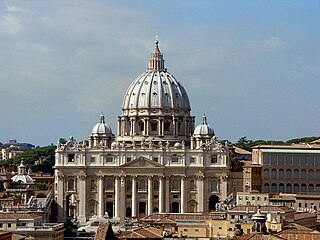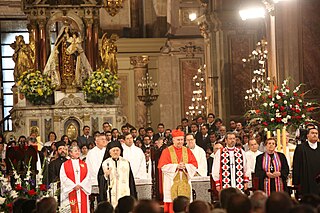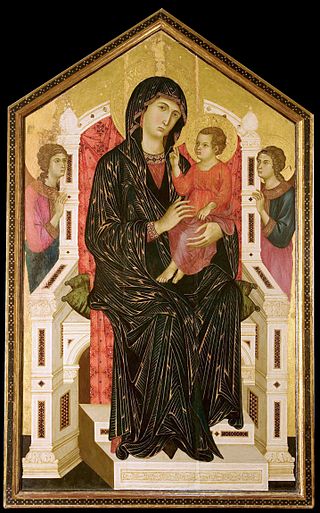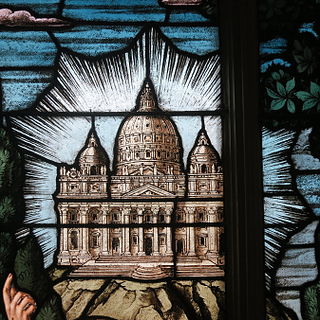Related Research Articles

The Second Ecumenical Council of the Vatican, commonly known as the Second Vatican Council or Vatican II, was the 21st and most recent ecumenical council of the Catholic Church. The council met in Saint Peter's Basilica in Vatican City for four periods, each lasting between 8 and 12 weeks, in the autumn of each of the four years 1962 to 1965.
Dignitatis humanae is the Second Vatican Council's Declaration on Religious Freedom. In the context of the council's stated intention "to develop the doctrine of recent popes on the inviolable rights of the human person and the constitutional order of society", Dignitatis humanae spells out the church's support for the protection of religious liberty. It set the ground rules by which the church would relate to secular states.

Ecumenism – also called interdenominationalism, or ecumenicalism – is the concept and principle that Christians who belong to different Christian denominations should work together to develop closer relationships among their churches and promote Christian unity. The adjective ecumenical is thus applied to any non-denominational initiative that encourages greater cooperation and union among Christian denominations and churches.
Satis cognitum is an encyclical of Pope Leo XIII dated 29 June 1896 on the unity of the Church, and some heresies of his time.
Mortalium animos is a papal encyclical promulgated in 1928 by Pope Pius XI on the subject of religious unity, condemning certain presumptions of the early ecumenical movement and confirming that the unique Church founded by Jesus Christ is the Catholic Church.
Ut unum sint is an encyclical by Pope John Paul II of 25 May 1995. It was one of 14 encyclicals issued by John Paul II. Cardinal Georges Cottier, Theologian emeritus of the Pontifical Household, was influential in drafting the encyclical.
Irenicism in Christian theology refers to attempts to unify Christian apologetical systems by using reason as an essential attribute. The word is derived from the Greek word ειρήνη (eirene) meaning peace. It is a concept related to a communal theology and opposed to committed differences, which can cause unavoidable tension or friction, and is rooted in the ideals of pacifism. Those who affiliate themselves with irenicism identify the importance of unity in the Christian Church and declare the common bond of all Christians under Christ.
Praeclara gratulationis publicae is an apostolic letter of Pope Leo XIII promulgated on 20 June 1894.

The Catholic Church has engaged in the modern ecumenical movement especially since the Second Vatican Council (1962–1965) and the issuing of the decree Unitatis redintegratio and the declaration Dignitatis humanae. It was at the Council that the Pontifical Council for Promoting Christian Unity was created. Those outside of the Catholic Church were categorised as heretics or schismatics, but in many contexts today, to avoid offence, the euphemism "separated brethren" is used.
Subsistit in is a Latin phrase which appears in Lumen gentium, the document on the church from the Second Vatican Council of the Catholic Church. Since the council, the reason for use of the term "subsists in" rather than simply "is" has been disputed. Generally, those who see little or no change in church teaching in Vatican II insist on the equivalence of subsistit in and "is". Those who point to a new, ecumenical thrust in Vatican II insist that the term was introduced as a compromise after much discussion, and acknowledges new elements in the council's teaching.
Charles Herman Helmsing was an American prelate of the Roman Catholic Church who served as bishop of the Diocese of Kansas City–St. Joseph in Missouri (1962–1977).

"That they all may be one" is a phrase derived from a verse in the Farewell Discourse in the Gospel of John (17:21) which says:
that they may all be one. As you, Father, are in me and I am in you, may they also be in us, so that the world may believe that you have sent me.

Mariological papal documents have been a major force that has shaped Roman Catholic Mariology over the centuries. Mariology is developed by theologians on the basis not only of Scripture and Tradition but also of the sensus fidei of the faithful as a whole, "from the bishops to the last of the faithful", and papal documents have recorded those developments, defining Marian dogmas, spreading doctrines and encouraging devotions within the Catholic Church.

Romano Amerio was a Swiss-Italian theologian and a late critic of post-Conciliar evolutions in liturgy and ecclesiology. His magnum opus is Iota Unum. It is a work dedicated to the study of the ruptures in Church teaching and tradition following the Second Vatican Council.

The Catholic Church and the Eastern Orthodox Church have been in a state of official schism from one another since the East–West Schism of 1054. This schism was caused by historical and language differences, and the ensuing theological differences between the Western and Eastern churches.
The Dicastery for Promoting Christian Unity, previously named the Pontifical Council for Promoting Christian Unity (PCPCU), is a dicastery within the Holy See whose origins are associated with the Second Vatican Council which met intermittently from 1962 to 1965.
Sister churches was a term used in 20th-century ecclesiology to describe ecumenical relations between the Roman Catholic Church and the Eastern Orthodox Churches, and more rarely and unofficially, between the Roman Catholic Church and the Anglican communion. The Catholic Church has since called on theologians to avoid the term, clarifying that "one cannot properly say that the Catholic Church is 'sister' of a particular Church or group of Churches. This is not merely a question of terminology, but above all of respecting a basic truth of the Catholic faith: that of the unicity [uniqueness] of the [Catholic Church]." The term is also currently used among Protestants to refer to different denominations of the same religious tradition.
Separated brethren is a term sometimes used by the Catholic Church and its clergy and members to refer to baptized members of other Christian traditions. The phrase is a translation of the Latin phrase fratres seiuncti. It is largely used as a polite euphemism in contexts where the terms "formal heretics" or "material heretics" might cause offense.

Catholic ecclesiology is the theological study of the Catholic Church, its nature, organization and its "distinctive place in the economy of salvation through Christ". Such study shows a progressive development over time being further described in revelation or in philosophy. Here the focus is on the time leading into and since the Second Vatican Council (1962–1965).

Catholic–Eastern Orthodox relations have warmed over the last century, as both churches embrace a dialogue of charity. The Second Vatican Council (1962-1965) ushered in a new era of relations for the Roman Church towards the Orthodox Church, fondly describing the Orthodox as “separated brethren” with valid sacraments and an apostolic priesthood. The Orthodox Church, on the other hand, encouraged local churches to prepare for future dialogue in the Third Pan-Orthodox Conference in Rhodes (1964), and has since engaged in several ecumenical efforts with the Vatican. Significantly, in 1965 Pope Paul VI and Ecumenical Patriarch Athenagoras I of Constantinople jointly lifted the mutual excommunications of 1054.
References
- ↑ Kasper, Walter (11 November 2004). "The Ecumenism Decree – read anew after 40 years". vatican.va. Archived from the original on 17 April 2005. Retrieved 21 June 2022.